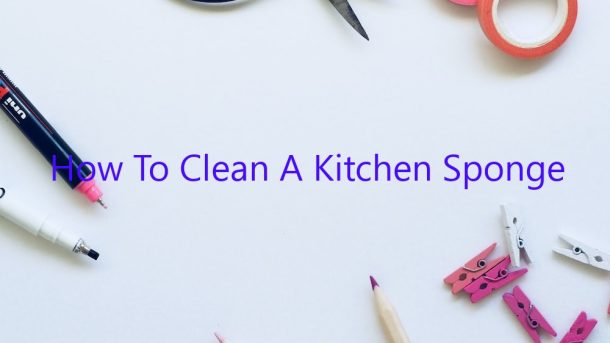A kitchen sponge is a very handy tool to have in the kitchen, but it can also be a breeding ground for bacteria if it is not cleaned properly. Here is a guide on how to clean a kitchen sponge:
Fill a bowl with warm water and add a few drops of dish soap.
Soak the sponge in the soapy water for a few minutes.
Rinse the sponge under running water.
Squeeze the sponge to remove excess water.
Dry the sponge with a paper towel.
Replace the sponge in the kitchen drawer.
Occasionally, it is a good idea to disinfect the sponge by boiling it in water for a few minutes.
Contents
- 1 How do you deep clean a kitchen sponge?
- 2 Does microwaving a sponge sanitize it?
- 3 Can you wash kitchen sponges?
- 4 How do you clean a kitchen sponge naturally?
- 5 How do you sanitize and disinfect a kitchen sponge?
- 6 How often should you replace your kitchen sponge?
- 7 How do I keep my kitchen sponge germ free?
How do you deep clean a kitchen sponge?
A kitchen sponge is one of the most important tools in your kitchen. Not only does it help you clean dishes, but it can also be used to scrub countertops and other surfaces. Over time, however, a kitchen sponge can become dirty and full of bacteria. This is why it’s important to deep clean your kitchen sponge on a regular basis.
There are a few different ways to deep clean a kitchen sponge. One way is to soak the sponge in a bleach solution. Another way is to microwave the sponge. And finally, another way is to put the sponge in the dishwasher.
Soaking the sponge in a bleach solution is the most effective way to kill bacteria. To do this, mix one part bleach with nine parts water. Soak the sponge in the solution for about five minutes. Then rinse the sponge with water and allow it to air dry.
Microwaving the sponge is a quick and easy way to kill bacteria. To do this, place the sponge on a paper towel and microwave it for about one minute. Then allow the sponge to cool before using it.
Putting the sponge in the dishwasher is another effective way to clean it. To do this, place the sponge in the dishwasher’s silverware basket. Then run the dishwasher on a hot cycle.
Does microwaving a sponge sanitize it?
Microwaving a sponge is a common way to sanitize it, but does it really work?
Sponges are often used to clean dishes and other surfaces in the kitchen. They can become dirty and covered in bacteria, so it’s important to sanitize them regularly. Microwaving a sponge is one way to do this, but does it actually work?
The truth is, there is no definitive answer. Some people claim that microwaving a sponge kills all of the bacteria on it, while others say it doesn’t do anything. The bottom line is that there is no scientific evidence to support either side.
So, what should you do? Well, if you’re comfortable with it, microwaving your sponge is probably a good way to sanitize it. Just be sure to keep an eye on it, and if it starts to smell bad or look discolored, get rid of it. Alternatively, you could try boiling it or using a disinfectant.
At the end of the day, it’s up to you to decide what you feel comfortable with. Just be sure to sanitize your sponge regularly to help keep your kitchen clean.”
Can you wash kitchen sponges?
Can you wash kitchen sponges? The answer is yes, you can wash kitchen sponges. Kitchen sponges can be washed in the dishwasher or in the sink with hot, soapy water.
Kitchen sponges should be washed regularly to keep them clean and free of bacteria. Bacteria can grow on kitchen sponges, so it is important to clean them often.
Kitchen sponges can be washed in the dishwasher or in the sink with hot, soapy water. The dishwasher is the best way to clean kitchen sponges, but the sink can be used if the dishwasher is not available.
Washing kitchen sponges in the dishwasher is the best way to clean them. The dishwasher will kill any bacteria on the sponges and will also clean them.
Washing kitchen sponges in the sink is the next best way to clean them. The hot, soapy water will kill any bacteria on the sponges and will also clean them.
Kitchen sponges should be cleaned regularly to keep them clean and free of bacteria. Washing them in the dishwasher or in the sink with hot, soapy water is the best way to clean them.
How do you clean a kitchen sponge naturally?
There are many ways to clean a kitchen sponge naturally. Some of the methods are simple and easy to do, while others are a little more involved.
One way to clean a kitchen sponge naturally is to soak it in vinegar. Vinegar is a natural disinfectant and can help kill bacteria and other germs. To soak the sponge, fill a bowl or container with vinegar and place the sponge inside. Let it soak for 30 minutes to an hour, then rinse it off with warm water.
Another way to clean a kitchen sponge naturally is to microwave it. Place the sponge on a plate and microwave it for one to two minutes. This will help kill any bacteria or germs on the sponge.
If neither of those methods work, you can also try using baking soda. Fill a bowl with baking soda and add the sponge. Soak the sponge for 30 minutes to an hour, then rinse it off with warm water. Baking soda is a natural disinfectant and can help kill bacteria and other germs.
How do you sanitize and disinfect a kitchen sponge?
A kitchen sponge can be a breeding ground for bacteria if not properly sanitized and disinfected. Here is a step-by-step guide on how to sanitize and disinfect a kitchen sponge:
1. Fill a pot with water and bring it to a boil.
2. Place the kitchen sponge in the boiling water and allow it to boil for 1-2 minutes.
3. Remove the kitchen sponge from the boiling water and rinse it with cold water.
4. Place the kitchen sponge in a dish drying rack and allow it to air dry.
How often should you replace your kitchen sponge?
How often should you replace your kitchen sponge?
That’s a question with a few different answers, as it depends on how you use your sponge, how long it lasts, and how dirty it gets.
Some people recommend replacing your kitchen sponge every week, while others say every month. Personally, I’d say every two weeks is a good rule of thumb.
If you’re using your sponge to clean dishes, it’s important to replace it regularly, as it can start to accumulate bacteria and other contaminants. Kitchen sponges can also be a breeding ground for mold, so it’s important to get rid of them when they start to look dirty or smell bad.
If you’re using your sponge to clean your countertops or other surfaces, it may last a little longer, but it’s still important to replace it regularly to prevent the build-up of bacteria and mold.
Ultimately, it’s important to replace your kitchen sponge when it starts to look and smell bad, regardless of how often you think you should be doing it.
How do I keep my kitchen sponge germ free?
A kitchen sponge is a handy tool to have around, but it can also be a breeding ground for germs if it’s not cleaned properly. Here are a few tips on how to keep your kitchen sponge germ free.
The first step is to replace your kitchen sponge regularly. A sponge that’s been used for a few days is a perfect breeding ground for bacteria, so it’s best to replace it every few days.
You can also sanitize your kitchen sponge by microwaving it for a minute or two. This will kill any bacteria or germs that may be on the sponge.
Another way to keep your kitchen sponge germ free is to soak it in bleach. This will kill any bacteria that may be on the sponge.
Finally, make sure to wash your hands after handling the kitchen sponge, especially if you’re going to be handling food. This will help prevent any bacteria from spreading.




